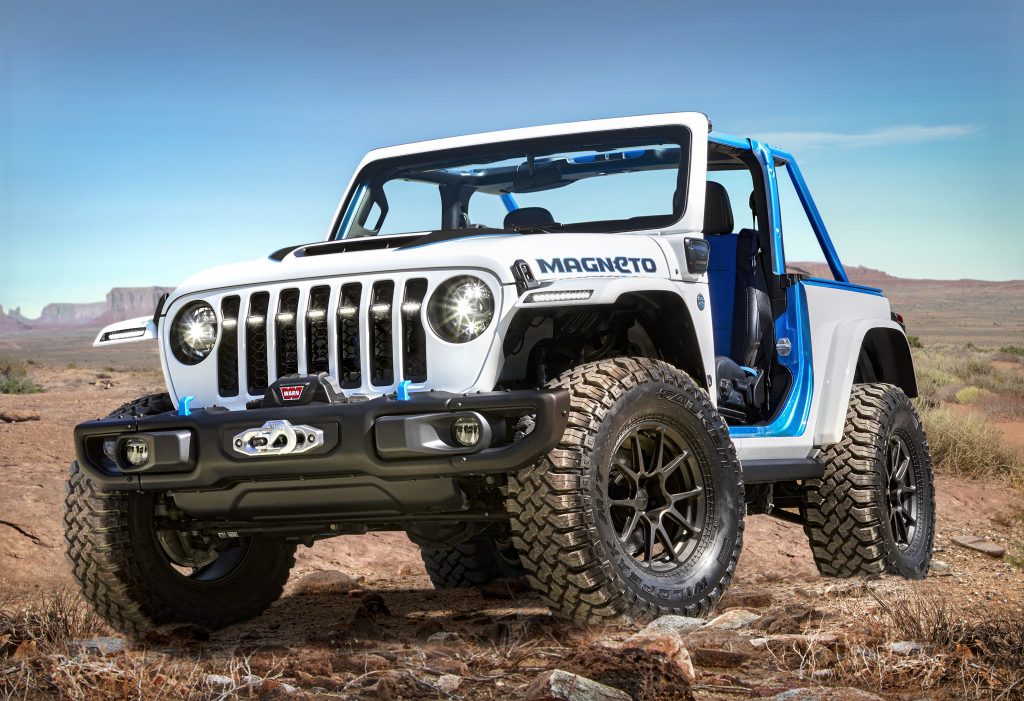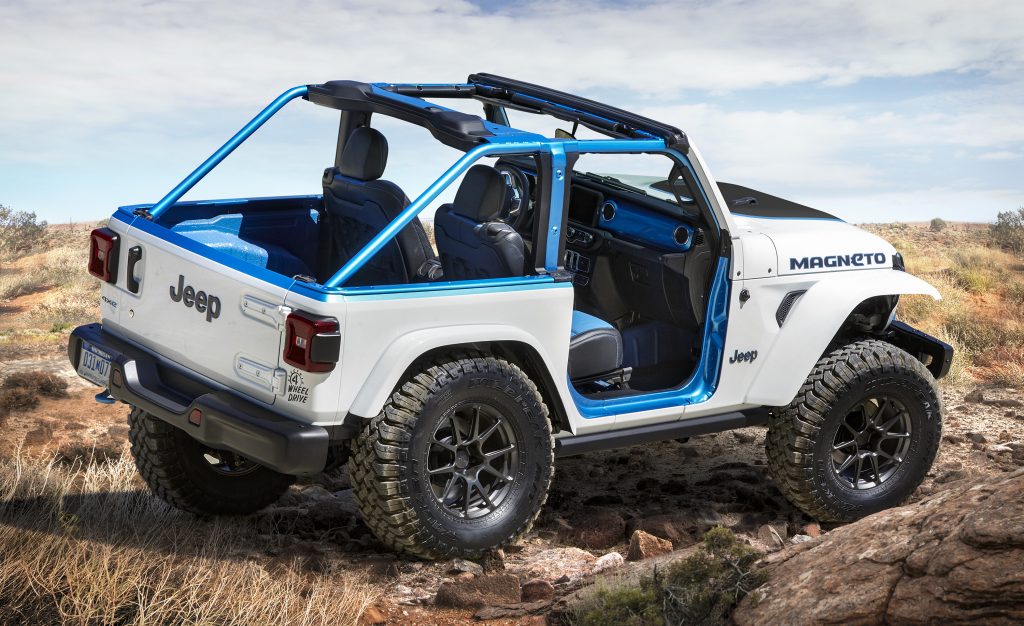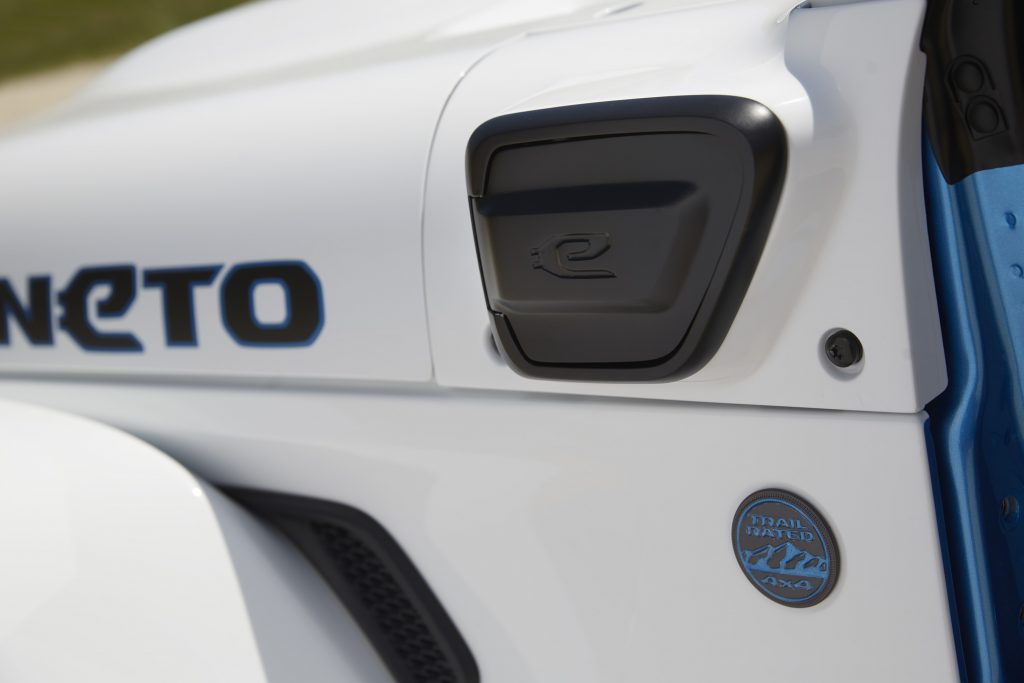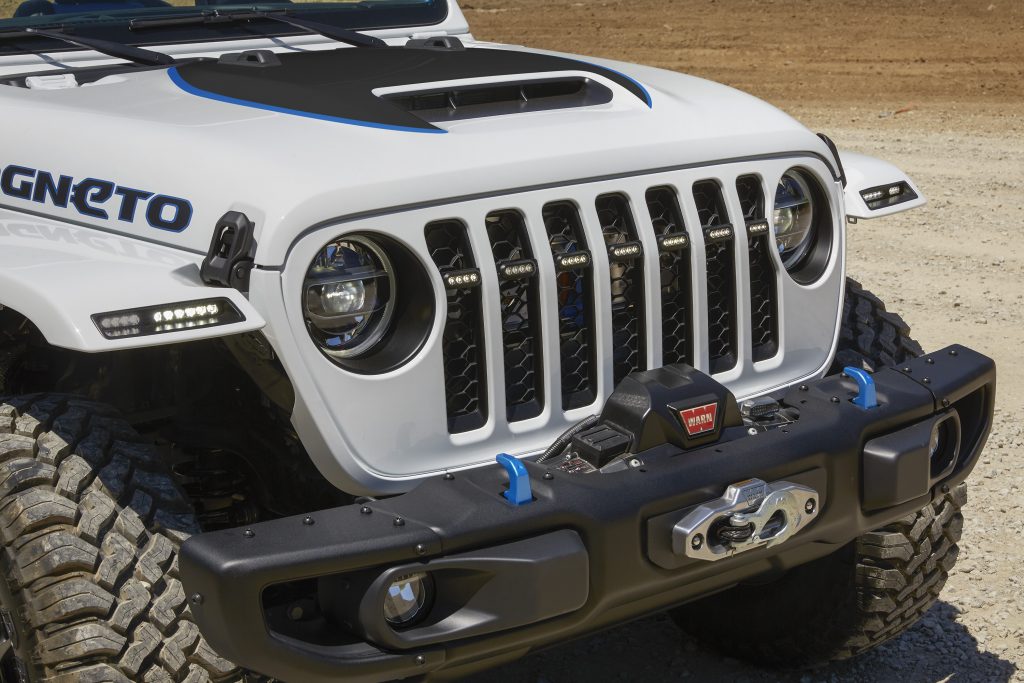
Earlier this week, Jeep unveiled its 2021 Easter Jeep Safari concept vehicles. While they’re all pretty awesome, one in particular caught our eye and we felt it warranted a closer look.
We’re talking about the Jeep Magneto, a Jeep Wrangler with an all-electric drivetrain. Even though electric vehicles are increasingly commonplace, the Magneto stands out as a pretty interesting concept. Here’s why.
To begin with, it’s an off-roader. Which means it must confront conditions that a normal EV would not—things like uneven terrain, high water, and extreme driveline angles. Next, the Magneto is an electrical retrofit of an existing design, which presents its own challenges. We’ve seen GM do this with success, so it’s nice to see another Big Three manufacturer swap an electric motor into a familiar chassis.

You Can Row Your Own Gears!
But what really piqued our curiosity is that, unlike many EVs, the Magneto features a traditional manual transmission and transfer case setup. That’s a pretty big deal for the off-roading crowd, where being able to modulate the throttle and control gearing are especially important.
Since an electric motor doesn’t have the traditional torque curve of an internal combustion engine, EVs nowadays often just rely on fixed gearing that makes shifting unnecessary. Conversely, Jeep says the Magneto’s clutch operates as it would with an internal combustion engine. Better still, in quick-shift scenarios, the electric motor even begins regen upon clutch engagement to prevent rev-hang.
While the practice isn’t new, mating an electric motor to a traditional gearbox is exciting for two big reasons. First, it could make it easier to swap EV drivelines into older vehicles. There’d be no need to radically modify the vehicle’s existing axle, suspension, steering, or brake systems—it’d be tantamount to something like an LS swap. Again, other companies are already making electric motor swap kits like this, but seeing it tackled by major automakers certainly adds to the potential feasibility.
Secondly, it satisfies the folks who lament the loss of shifting gears. For some purists, ditching a clutch and shift lever for a shiftless EV is an absolute deal breaker for electric vehicle adoption. And it could bring us one step closer to bolting an electric motor to a Muncie M22, and dropping the whole thing into, say, a 1960s-era Chevelle.

The Jeep Magneto’s Electric Motor
Jeep explains that the Magneto’s custom-made axial flux electric motor was designed to emulate the performance of the venerable 3.6L Pentastar V6 that’s been powering Wranglers for about a decade now. The electric motor revs up to 6,000 rpm and makes up to 285 horsepower and 273 lb.-ft. of torque, which is actually a slight bit better than the current Pentastar’s 285 hp/260 lb.-ft. performance combo. Jeep says, outside of its whisper-quiet operation, the electric motor feels pretty much the same as the Pentastar under moderate driving.
In terms of straight line speed, that electric drivetrain allows the Magneto to hustle from zero to sixty in 6.8 seconds.
Where Did Jeep Stick the Magneto’s Batteries?
Perhaps the biggest hurdle with an electric driveline is what to do with the batteries. They’re big and heavy, so placement can have a direct impact on an EV’s balance, performance, and handling. And that’s particularly important when building a vehicle designed to head off-road.
Understanding this, Jeep engineers devised a way to use four separate battery backs to power the Magneto’s electric motor. This allowed designers to position the battery packs around the Wrangler’s chassis to improve weight balance at each wheel. According to Jeep, “one pack replaces the Wrangler’s mid-ship fuel tank, another is mounted opposite the fuel tank location, the third pack sits atop the e-motor under the hood, and the fourth pack mounts in the space normally used for a rear storage compartment, also using space typically occupied by the exhaust muffler.”
The Magneto also has a pair of supplemental 12-volt batteries to drive the Jeep’s accessory systems, like the radio, heater, headlights, and winch. That’s not unusual either—separate 12V battery setups are really common in electric vehicles nowadays, because they eliminate the need for a lot of cumbersome voltage converters and transformers.
The batteries receive special mounts and armor cladding to protect them from the rigors of off-roading.

The Silent Future of Off-Roading
One of the ancillary benefits of an electric off-roader is noise reduction, and that’s something Jeep is highlighting in its advertising. To many outdoor enthusiasts, a quiet-running EV would be a welcome replacement for an internal combustion engine. And the Magneto’s occupants would benefit from being able to “sneak up” on nature, while creating a smaller impact on the outdoor environment around them.
While it’s tough to accurately predict what the future of off-roading will look like, it’s a pretty safe bet that electric vehicles will play a significant role in it, especially when you consider the advent (and advantages) of other electric off-road vehicles like dirt bikes, side-by-sides, and four-wheelers.
At this point though, the Jeep Magneto is strictly a concept vehicle.
Regardless, it’s an awesome step forward in the evolution of electric off-road vehicles—and there’s no surprise that it’s wearing a Jeep badge.

Comments